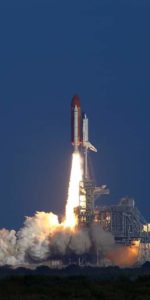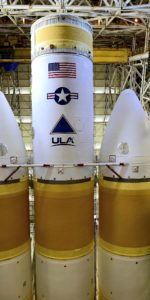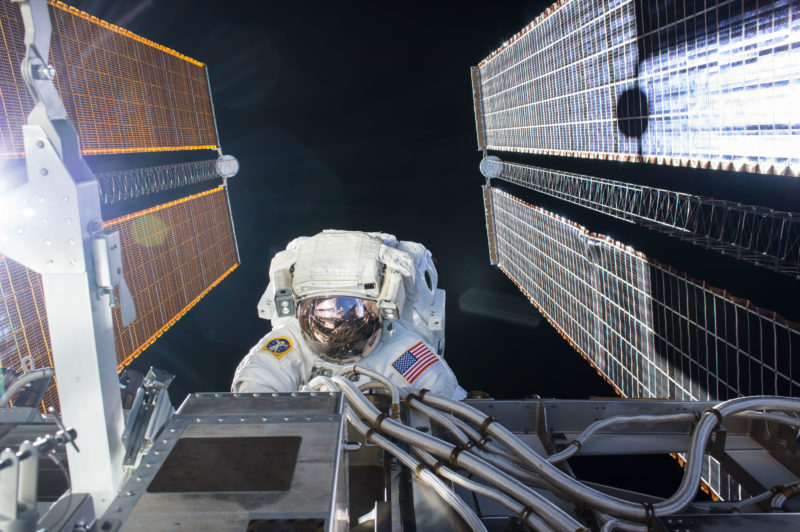
A pair of Artemis Team astronauts, who may—just may—someday leave their bootprints on the rugged terrain of the Moon’s South Pole, will begin an extensive campaign of power system upgrades on the International Space Station (ISS) this coming Sunday. Expedition 64 spacewalkers Kate Rubins (EV1) and Victor Glover (EV2) will spend about 6.5 hours outside the sprawling orbital outpost, preparing the P-6 truss worksite for the arrival and installation of the first set of ISS Roll-Out Solar Arrays (iROSAs), later this year.
As previously outlined by AmericaSpace, the iROSA upgrades program will eventually see six new arrays installed to “shadow” and work in tandem with eight “legacy” arrays on the port and starboard sides of the expansive Integrated Truss Structure (ITS).
Between them, Rubins and Glover have already logged more than 25 hours of Extravehicular Activity (EVA) time on four prior spacewalks, most recently at the beginning of February. Rubins spent a total of 12 hours and 46 minutes working in the near-total vacuum of space back in the summer of 2016, when she and Expedition 48 Commander Jeff Williams completed the installation of the first International Docking Adapter (IDA), fitted a new suite of high-definition external cameras and retracted and secured the Trailing Thermal Control Radiator (TTCR) at the P-6 worksite.
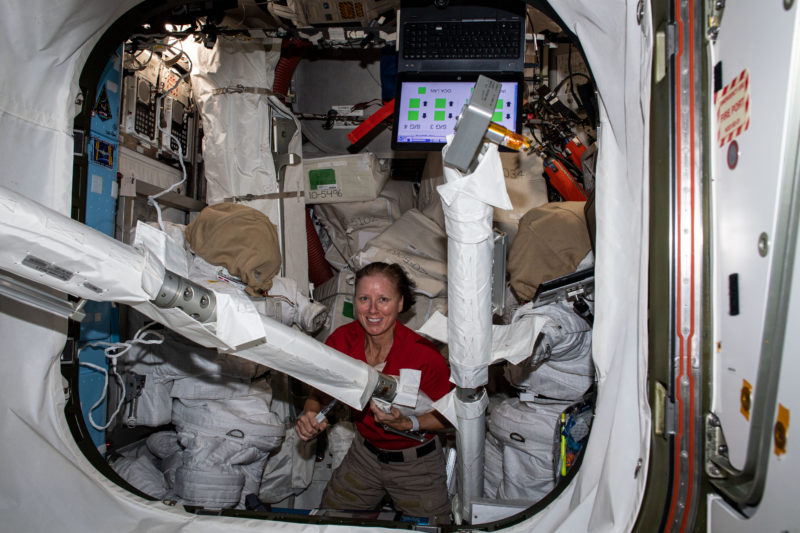
More recently, earlier this spring, Glover and Expedition 64 crewmate Mike Hopkins labored outside for 12 hours and 16 minutes, working towards the activation of the Bartolomeo payloads-anchoring platform on Europe’s Columbus lab, installing the Columbus Ka-Band Antenna (COL-Ka) and putting the finishing touches on a four-year-plus series of ISS battery upgrades.
As such, with Sunday’s planned spacewalk, both Rubins and Glover will be embarking on the third EVAs of their respective careers. Designated “U.S. EVA-71”, it will be the 71st ISS-based spacewalk in U.S.-built Extravehicular Mobility Units (EMUs), conducted in the absence of the Space Shuttle, since Expedition 4 crewmen Carl Walz and Dan Bursch floated outside on U.S. EVA-1, way back in February 2002.
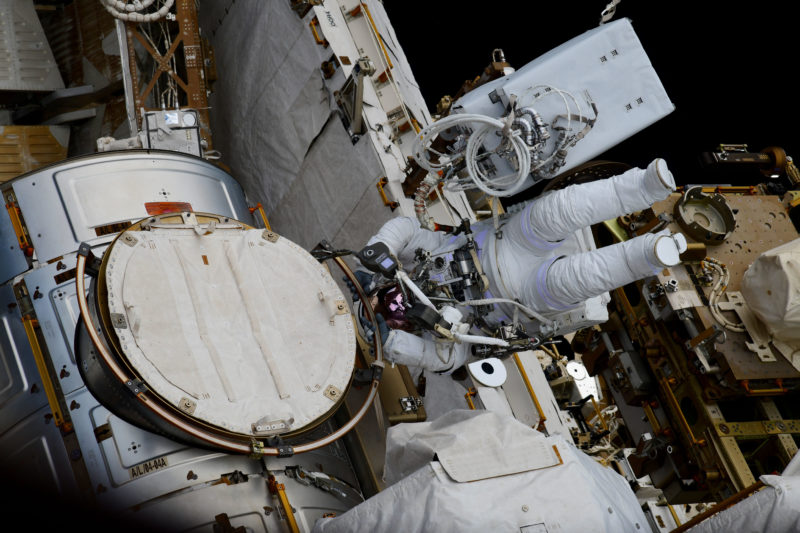
In a briefing Wednesday, a panel of ISS Program experts summarized the tasks for Sunday’s spacewalk, as well as assigned work for a second EVA planned for Friday, 5 March, which will again feature Rubins, teamed this time with Japanese astronaut Soichi Noguchi. Leading both EVAs is Spacewalk Officer Art Thomason, with Flight Director Marcos Flores on console in Mission Control and astronaut (and fellow “Artemis Team” cadre member) Frank Rubio as the Ground Intravehicular (IV) communicator, talking directly to Rubins and Glover.
Although in the planning stages for several years, it was only last month that NASA and Boeing announced their intent to equip the station’s U.S. Operational Segment (USOS) with six new power-generating arrays over the next couple of years.
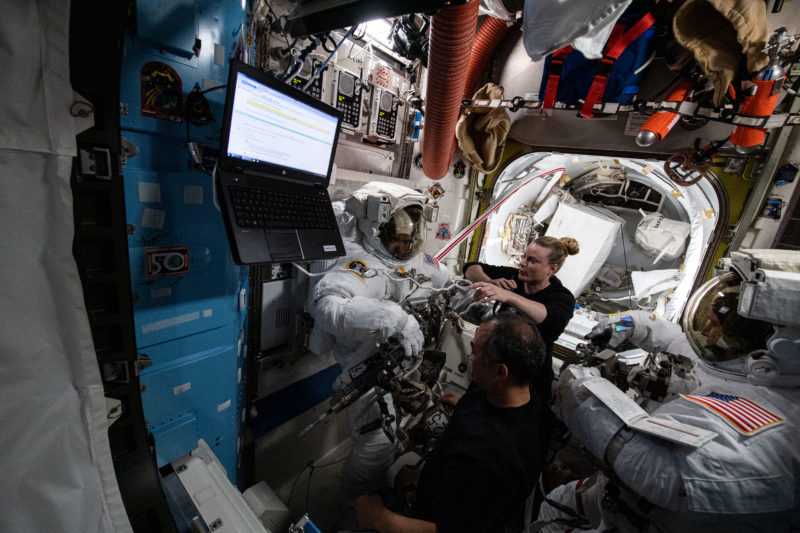
In his remarks yesterday, ISS Deputy Program Manager Kenny Todd explained that the new arrays will effect an electricity-generating “hike” for the USOS from the present 160 kilowatts to around 215 kilowatts, as part of efforts to satisfy power requirements “that we didn’t even dream of in the mid-90s”. He added that “more and more requests for power”, including the recent arrival of Bartolomeo and its steadily growing backlog of payload customers, prompted the iROSA upgrade as “more of a robustness increase”.
In its present form, the ITS possesses eight massive truss segments—P-6 and P-4 on the port side and S-6 and S-4 on the starboard, plus adjunct structural members—which were launched and installed by successive Space Shuttle astronauts between December 2000 and March 2009. Each truss houses a pair of giant Solar Array Wings (SAWs) and a pair of power channels to contribute to the station’s voracious demands for electrical energy, power storage and distribution and cooling. After well over a decade in space for even the youngest truss segments, until now none of them has been upgraded.
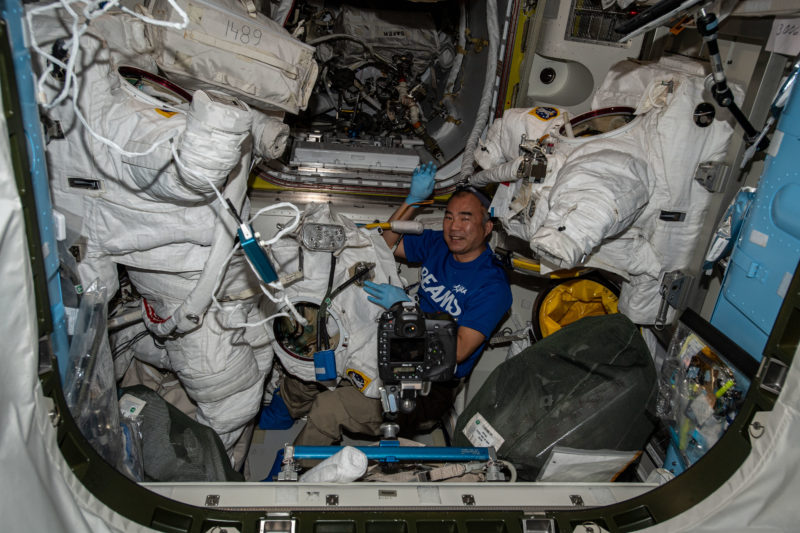
In June 2017, SpaceX’s CRS-11 Dragon cargo ship carried the Roll-Out Solar Array (ROSA) to the station, where it was intended for use as a short-term technology demonstration for more compact power-producing systems. Twenty percent lighter and four times smaller than extant rigid-panel solar arrays, and specially engineered for enhanced structural stiffness and strength, ROSA was held in the grasp of the 57.7-foot-long (17.6-meter) Canadarm2 for a few days of tests before it was discarded.
The success of ROSA allowed plans to enter high gear for six iROSA arrays to augment the ISS power system for the first time in more than a decade. Last July, Expedition 63 spacewalkers Chris Cassidy and Bob Behnken removed a pair of “H-Fixtures” from the base of the solar arrays to make room for the iROSA “mod-kit”. The specific kit that Rubins and Glover will install was delivered to the ISS aboard Northrop Grumman Corp.’s NG-14 Cygnus cargo ship last October and temporarily stored in the end-cone of the Leonardo Permanent Multipurpose Module (PMM).
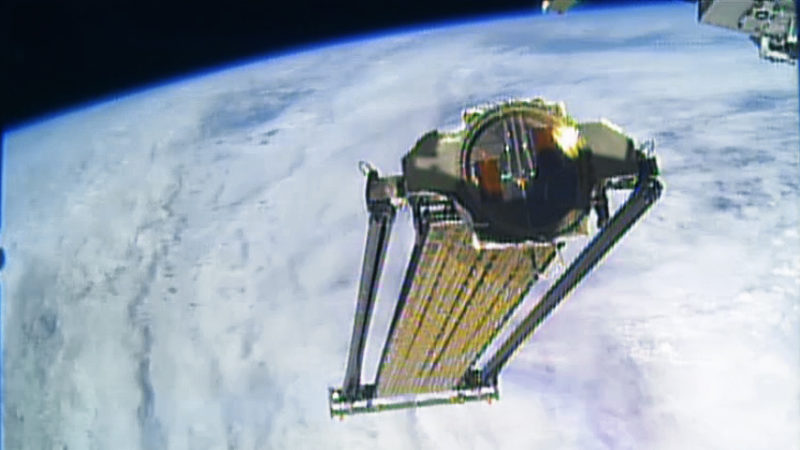
Although NASA previously noted that replacing all eight ISS power channels “would provide the most operational flexibility for the program”, the plan to upgrade only six channels through iROSA is “the minimum amount required to avoid negatively impacting ISS operations”. When installed, the six arrays will cover (and “shadow”) about two-thirds of each legacy array, whose unshadowed portion will remain active. “The two arrays are electrically combined,” NASA explained, “and both provide power to the ISS, resulting in an increase in power performance compared to the legacy ISS solar array.”
The first pair of iROSA arrays—and the targeted worksite for Rubins and Glover on Sunday—will be installed onto the oldest set of legacy arrays: Power Channels 2B and 4B on the P-6 truss, which passed 20 years in space last winter. Power Channel 2B comprises its two Earth-facing wings, whilst Power Channel 4B comprises the two space-facing wings. Next up on later spacewalks, both power channels on the S-4 truss and one power channel apiece on P-4 and S-6 will also receive iROSA upgrades.
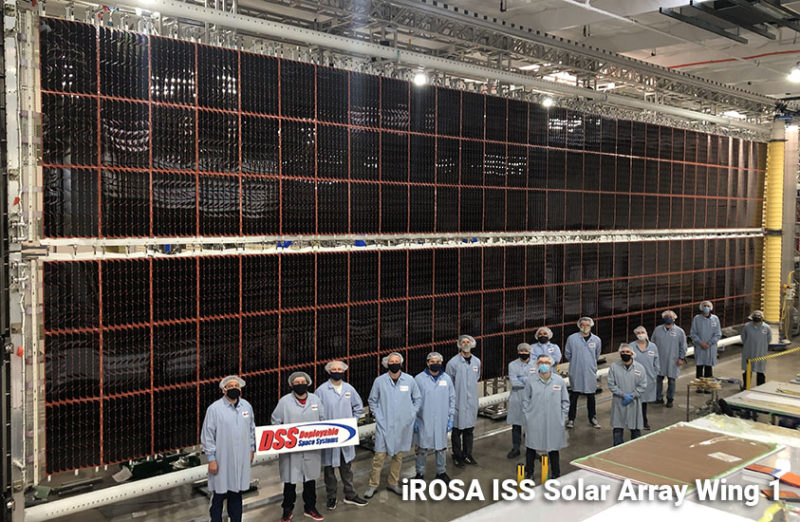
“This specific iROSA configuration was selected after careful consideration to balance observed degradation in the legacy solar arrays with the anticipated demand on each channel,” NASA’s Gary Jordan previously told AmericaSpace.
In readiness for Sunday’s EVA-71, Rubins and Glover have spent much time this week inside the Quest airlock, servicing their suits and configuring their tools. They recharged and cleaned water coolant loops and checked out caution-and-warning displays, glove heaters, helmet cameras and batteries. On Wednesday, they were joined by Hopkins and Noguchi to perform “fit-checks” of their suits—with Rubins set to wear EMU No. 3015 and Glover EMU No. 3009—and later participated in a review of EVA-71 procedures with teams at Mission Control.
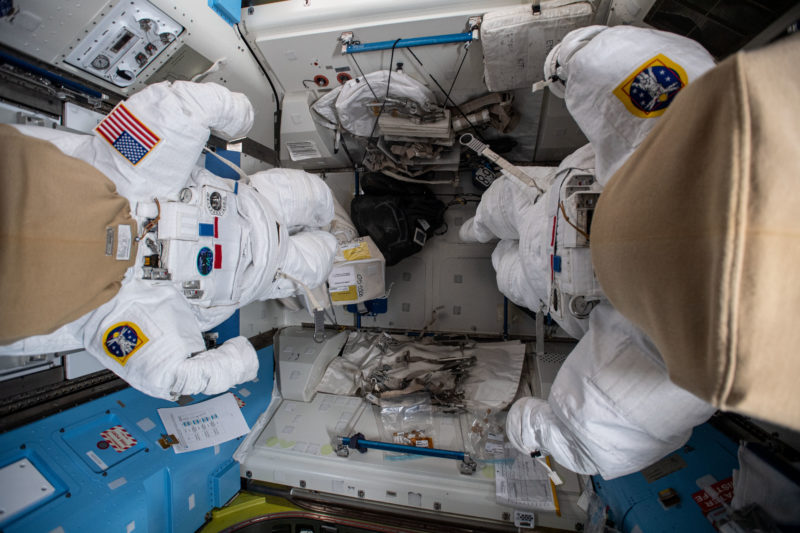
With Hopkins and Noguchi helping to suit them up and get them out the door, Sunday’s spacewalk is targeted to kick off around 6 a.m. EST. Rubins will exit the airlock first, followed by Glover, who will pass out an 8-foot-long (2.4-meter) bag carrying the structural members of the 330-pound (150 kg) mod-kit. Glover will make his way to the station’s P-1 truss, where he will install hooks for safety tethers to provide 170 feet (52 meters) of linkage to get them out to the far-outboard P-6 worksite. Arriving there, they will stow their bags as Rubins retrieves and ingresses an Articulating Portable Foot Restraint (APFR).
The work will then begin in earnest at Power Channel 2B. Rubins and Glover will assemble a mounting bracket and an upper and lower strut to form the so-called “upper triangle”, which will be bolted via the Pistol Grip Tool (PGT) onto the Mast Canister. They will then repeat the task, virtually in a mirror image, to build and install the upper triangle for Power Channel 4B, with a minimum requirement that its lower strut must be in place to have the ISS in a proper configuration before heading back to the airlock.
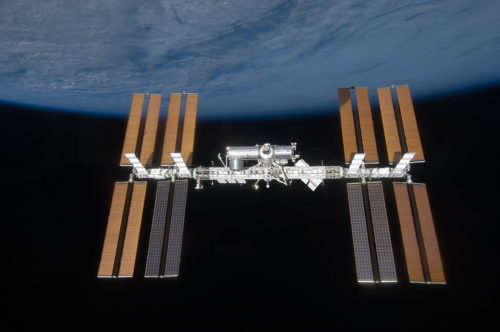
If Rubins and Glover work ahead of the timeline, they will press ahead to complete the assembly and installation of both mod-kits. A second mod-kit will ride uphill aboard Northrop Grumman’s NG-16 Cygnus in July, with a third kit due for delivery to NASA this spring.
The mod-kit to be installed by Rubins and Glover will thus provide a mounting location for the first set of iROSA arrays, due to arrive at the station in May aboard SpaceX’s CRS-22 Dragon. And the first spacewalk devoted to installing the new arrays—for the P-6 truss—is expected later this summer. Subsequent iROSA kits are “under review” to be manifested on the CRS-24 and CRS-25 Dragons, currently scheduled to fly next year.




